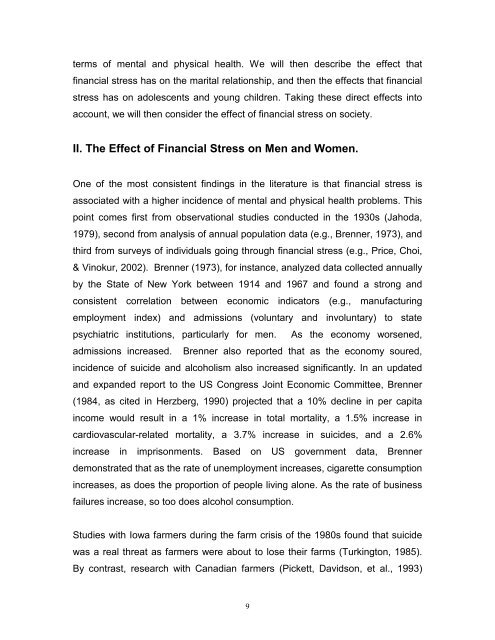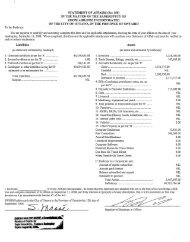Download the Carleton University Report (PDF). - Doyle Salewski Inc
Download the Carleton University Report (PDF). - Doyle Salewski Inc
Download the Carleton University Report (PDF). - Doyle Salewski Inc
Create successful ePaper yourself
Turn your PDF publications into a flip-book with our unique Google optimized e-Paper software.
terms of mental and physical health. We will <strong>the</strong>n describe <strong>the</strong> effect that<br />
financial stress has on <strong>the</strong> marital relationship, and <strong>the</strong>n <strong>the</strong> effects that financial<br />
stress has on adolescents and young children. Taking <strong>the</strong>se direct effects into<br />
account, we will <strong>the</strong>n consider <strong>the</strong> effect of financial stress on society.<br />
II. The Effect of Financial Stress on Men and Women.<br />
One of <strong>the</strong> most consistent findings in <strong>the</strong> literature is that financial stress is<br />
associated with a higher incidence of mental and physical health problems. This<br />
point comes first from observational studies conducted in <strong>the</strong> 1930s (Jahoda,<br />
1979), second from analysis of annual population data (e.g., Brenner, 1973), and<br />
third from surveys of individuals going through financial stress (e.g., Price, Choi,<br />
& Vinokur, 2002). Brenner (1973), for instance, analyzed data collected annually<br />
by <strong>the</strong> State of New York between 1914 and 1967 and found a strong and<br />
consistent correlation between economic indicators (e.g., manufacturing<br />
employment index) and admissions (voluntary and involuntary) to state<br />
psychiatric institutions, particularly for men. As <strong>the</strong> economy worsened,<br />
admissions increased. Brenner also reported that as <strong>the</strong> economy soured,<br />
incidence of suicide and alcoholism also increased significantly. In an updated<br />
and expanded report to <strong>the</strong> US Congress Joint Economic Committee, Brenner<br />
(1984, as cited in Herzberg, 1990) projected that a 10% decline in per capita<br />
income would result in a 1% increase in total mortality, a 1.5% increase in<br />
cardiovascular-related mortality, a 3.7% increase in suicides, and a 2.6%<br />
increase in imprisonments. Based on US government data, Brenner<br />
demonstrated that as <strong>the</strong> rate of unemployment increases, cigarette consumption<br />
increases, as does <strong>the</strong> proportion of people living alone. As <strong>the</strong> rate of business<br />
failures increase, so too does alcohol consumption.<br />
Studies with Iowa farmers during <strong>the</strong> farm crisis of <strong>the</strong> 1980s found that suicide<br />
was a real threat as farmers were about to lose <strong>the</strong>ir farms (Turkington, 1985).<br />
By contrast, research with Canadian farmers (Pickett, Davidson, et al., 1993)<br />
9





